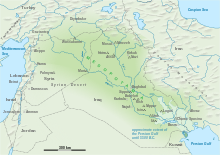User:Claireneal/History of Waste Management
Early History
[edit]
The first known wastewater management system is located in present day Syria (El Kowm). Located in the Fertile Crescent, the Mesopotamian "oasis" shows evidence of wastewater management beginning around 6500 BCE. The area is about 120 km northeast of the ancient city of Palmyra.[1] The site of El Kowm had vast urban planning centered around domestic wastewater drainage.[2] There is a sophisticated gutter system within residences, as well as the connection of these gutter/drainage systems to larger systems within the city. The fluids were transported through these gutter systems from residences into ditches in the streets of the city.[3] Additionally, there are other planned systems in the cities in surrounding areas, suggesting that there was diffusion of waste management techniques throughout the region.[4] Many of these systems include settling chambers to mitigate the blockages that often occur in sewage systems.[5] These chambers provide space for sediment deposits to build up without interfering with the flow of the sewer. In addition to these systems in Syria, there is also evidence of sophisticated waste management systems within other societies in the past.

The Ancient Roman Empire used sophisticated aqueduct and waste removal systems throughout their empire.[6] Utilizing the Cloaxa Maxima, the engineers of Ancient Rome created a vast network of sewers.[7] The Cloaxa Maxima emptied into the Tiber River, resulting in extreme pollution. This pollution led to the contamination of the drinking water used by the Romans (taken from the Tiber). The need for fresh water ultimately resulted in the development of the aqueduct technology.[8] The broader span of aqueducts generally utilized pipes made out of lead, while the pipes within the cities themselves were often made of ceramic, wood, and leather. There were distinct differences in quality of waste management practices between the socioeconomic classes. Access to the sewer systems, as well as having plumbing and other water-based luxuries, was seen as a sign of status in Roman society. Access was only granted to those who paid for it. Additionally, archaeological sites and ancient texts show evidence of the first European waste management labor force.[6] Duties performed by this force include collecting stored waste from houses not connected to the sewer system, and selling the waste to farmers for profit. The households utilizing these services were also required to pay. Compared to the systems utilized by the Fertile Crescent civilizations, the waste management systems of the Ancient Roman Empire were largely socially stratified, depending heavily on the socioeconomic status of the civilians. This stratification within waste management systems can also be viewed in Ancient Egypt.[9][10]Another unique form of water/waste management was within the Aztec Empire.
- ^ Dornemann, Rudolph Henry (1986). A Neolithic village at Tell el Kowm in the Syrian Desert. Chicago, Ill.: Oriental Institute of the University of Chicago. ISBN 0-918986-45-1. OCLC 15583951.
- ^ "Ancient Water Technologies | SpringerLink" (PDF). doi:10.1007/978-90-481-8632-7.pdf.
{{cite journal}}: Cite journal requires|journal=(help) - ^ "Mesopotamia | Anecdotes, History, Writing..." 2019-11-25. Retrieved 2021-04-13.
- ^ Mays, Larry W. (2017-10-01). "Survey of ancient water technologies in semi-arid and arid regions: traditional knowledge for the future". Water Supply. 17 (5): 1278–1286. doi:10.2166/ws.2017.027. ISSN 1606-9749.
- ^ Bertrand-Krajewski, J.-L. (2003-02-01). "Sewer sediment management: some historical aspects of egg-shaped sewers and flushing tanks". Water Science and Technology. 47 (4): 109–122. doi:10.2166/wst.2003.0233. ISSN 0273-1223.
- ^ a b Havlíček, Filip; Morcinek, Miroslav (2016-12-01). "Waste and Pollution in the Ancient Roman Empire". Journal of Landscape Ecology. 9 (3): 33–49. doi:10.1515/jlecol-2016-0013. ISSN 1805-4196.
- ^ Hopkins, John; Stow, Kenneth, "The 'sacred sewer': tradition and religion in the Cloaca Maxima", Rome, Pollution and Propriety, Cambridge: Cambridge University Press, pp. 81–102, ISBN 978-1-139-02847-9, retrieved 2021-03-31
- ^ "WaterHistory.org". www.waterhistory.org. Retrieved 2021-03-31.
- ^ Angelakis, Andreas N.; Yun, Zheng Xiao (2013-05-01). "Editorial: Probing the past and facing the future". Water Supply. 13 (3): 561–563. doi:10.2166/ws.2013.151. ISSN 1606-9749.
- ^ Eslamian, Saeid (2014-03-21). Handbook of Engineering Hydrology: Environmental Hydrology and Water Management. CRC Press. ISBN 978-1-4665-5250-0.
